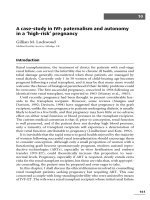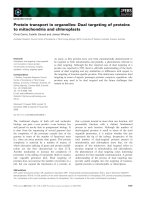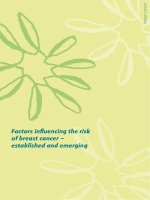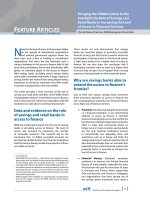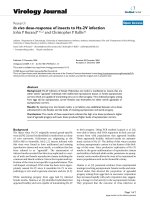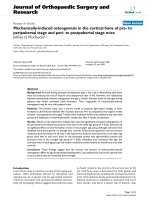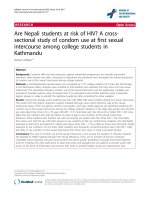Assessing latent inhibition deficits in youth at risk of conversion to psychosis
Bạn đang xem bản rút gọn của tài liệu. Xem và tải ngay bản đầy đủ của tài liệu tại đây (956.77 KB, 68 trang )
ASSESSING LATENT INHIBITION DEFICITS IN YOUTH AT-RISK OF
CONVERSION TO PSYCHOSIS
JAMIE THONG YU JIN
(B.Soc.Sci (Hons.)), NUS
A THESIS SUBMITTED
FOR THE DEGREE OF MASTER OF SOCIAL SCIENCES
DEPARTMENT OF PSYCHOLOGY
NATIONAL UNIVERSITY OF SINGAPORE
2012
Acknowledgements
I would like to thank my supervisor, Dr Simon L. Collinson, for being willing to
take me on as a student despite his busy schedule. Without his guidance and advice
throughout the course of my studies it would not have been possible to finish this
thesis.
I am very grateful to Associate Professor Chong Siow Ann, Dr Mythily
Subramaniam and Ms. Patricia T. Kin from the Institute of Mental Health Research
Division. Without their continuous support, advice and understanding, I would not
have been able to make it this far. They gave me the opportunity to serve as project
lead on the Neurocognitive Core and out of these meetings emerged the idea for this
thesis. I especially want to thank Dr Mythily for being willing to lend me her ears
when I needed to discuss my thoughts and ideas with someone. Her comments were
always insightful and helped to crystallize my thoughts.
Dr. Attilio Rapisarda has been a great help to me in many ways in matters
related to neurocognition. Thank you for being willing to discuss my thoughts and
ideas no matter what topic they were on. I also thank Dr. Edimansyah Abdin who has
been a great help to me in matters of statistics.
The data used in this thesis was collected by all the team members of the
Longitudinal Youth At-Risk Study. Despite the difficulties we encountered, we
persevered. Thank you everyone for your effort. Special mentions go out to my
friends the “Pansies” and the “Old People” for all the moments of laughter they
provided. You guys are the best!
i
I want to thank Professor Richard S. E. Keefe from Duke University for his
support and Mr. Michael Kraus for his work in programming the MATLAB script, and
classifying participants’ strategies. I also want to thank Mr. Kraus for his assistance to
me with regards to analysing the data.
Finally, I thank the Lord Jesus Christ who has helped me to complete this
thesis. It is His grace, strength and guidance that has brought me this far. Because of
all He has done and all the people He has placed in my life, I am able to complete this
work. Thank You Jesus for everything. All glory to God!
ii
Table of Contents
Page
Acknowledgements
i
Table of Contents
iii
Thesis summary
vii
List of Tables
ix
List of Figures
x
Chapters
1.
Psychosis and Its Prodrome
1
2.
Neurocognitive Function of Ultra High Risk Individuals
2
3.
What is Latent Inhibition?
3
4.
Latent Inhibition and Dopamine
5
5.
Latent Inhibition, Dopamine, and Ultra High Risk Individuals
7
6.
Study 1
8
6.1.
Introduction
8
6.2.
Method
11
6.2.1. Study Sample
11
6.2.2. Screening for Ultra High Risk Status
12
iii
7.
6.2.3. Administration of the LI Paradigm
13
6.2.4. Apparatus
14
6.2.5. Procedure
14
6.3.
Statistical Analysis
15
6.4.
Results
16
6.5.
Discussion
16
Study 2
18
7.1.
Introduction
18
7.2.
Method
19
7.2.1. Study Sample, Ultra High Risk Screening and
Administration of the Latent Inhibition Paradigm
8.
19
7.2.2. Apparatus
20
7.2.3. Procedure
20
7.3.
Statistical Analysis
22
7.4.
Results
22
7.5.
Discussion
26
Study 3
28
8.1.
28
Introduction
iv
8.2.
Method
29
8.2.1. Study Sample, Ultra High Risk Screening and
Administration of the Latent Inhibition Paradigm
9.
29
8.2.2. Breakdown of CAARMS Groupings
30
8.2.3. Apparatus
30
8.2.4. Procedure
31
8.3.
Statistical Analysis
31
8.4.
Results
32
8.5.
Discussion
35
General Discussion
36
9.1.
37
Possible Applications of Latent Inhibition
9.1.1. Using Latent Inhibition to Differentiate “Converters”
From “Non-converters”
37
9.1.2. Using Latent Inhibition Paradigms as a Mass-Screening
Tool
9.2.
38
Possible Explanations for the Strategy Effect
39
9.2.1.
39
A Cultural Difference?
9.2.2. A Problem with the Design of the Paradigm?
40
v
9.3.
9.4.
9.5.
9.6.
10.
Further Improvements to the Paradigm
41
9.3.1. An Issue of Pre-exposure Duration
42
9.3.2. An Issue of Task Brevity
42
Strengths
43
9.4.1. Extension of Current Knowledge
43
9.4.2. Generalizable Findings
43
Limitations
44
9.5.1. Small Sample Size
44
9.5.2. Possible Misclassification of Participants
45
Conclusion
45
References
46
vi
Summary
In recent years there has been much interest in the psychosis prodrome, the
period that directly precedes the onset of psychotic illness. Past research has found
that prodromal individuals demonstrate various neurocognitive deficits when
compared to healthy individuals. Despite being well studied in patients with
schizophrenia little or no research has examined Latent Inhibition (LI), a cognitive
phenomenon where simple exposure to a stimulus without pairing to a consequence
lowers the future associability of that stimulus to events, in at-risk individuals. As LI is
sensitive to fluctuations in dopamine levels, it has potential as a method for
detecting disrupted dopaminergic systems. This thesis describes the use of a novel LI
paradigm to investigate LI deficits in individuals who have been identified to be at
Ultra High Risk (UHR) of transition to psychosis.
Three studies are described in this thesis. Study 1 attempted to validate the
novel LI paradigm for use in an Asian population taking into account cigarette
smoking as a mediating variable of dopaminergic level and thereby LI. Sixty healthy
participants (30 smokers and 30 non smokers) were tested. No significant
differences in reaction times were found between the Pre-Exposed (PE) and Non
Pre-Exposed (NPE) conditions in either group. However, the data showed that some
participants showed a LI effect regardless of smoking status. Study 2 was conducted
to determine what influenced participants’ performance on the LI task. The LI
paradigm was administered on 109 healthy participants, and their strategies in
approaching the task were collected. The results show that the strategy reported by
vii
participants significantly influenced the results. Only when participants utilized one
particular strategy (dubbed the Optimal strategy) did they show a LI effect.
In Study 3, 52 participants who met UHR criteria were tested with the LI
paradigm, and their strategy information was collected. The results showed that
even in the group which utilized the “Optimal” strategy, there were no differences
between PE and NPE reaction times. This indicated the absence of a LI effect. The
findings are consistent with prior research on LI in individuals with schizophrenia,
and the results provide support for the possibility of a disrupted dopaminergic
system in UHR individuals.
viii
List of Tables
Page
1.
Sample Characteristics (Study 1)
2.
Number of Participants for Each Strategy and Examples of
12
Responses (Study 2)
21
3.
Mean PE and NPE Reaction Times and SDs for Each Strategy (Study 2)
25
4.
Mean Differences, SDs and P-Values of Strategy Group for the PE
5.
And NPE Conditions (Study 2)
25
Number of Participants for Each Strategy (Study 3)
31
ix
List of Figures
Page
1.
Reaction Times for Each Strategy Type by Block and Condition (Study 2)
24
2.
PE minus NPE Reaction Times by Strategy Type and Block (Study 2)
24
3.
Venn Diagram Depicting CAARMS Groupings (Study 3)
30
4.
Reaction Times by Block and Condition for Optimal and
Ambiguous/None strategy types (Study 3)
5.
34
PE minus NPE Reaction Times by Block for Optimal and
Ambiguous/None strategy types (Study 3)
34
x
1. Psychosis and Its Prodrome
Psychotic disorders such as schizophrenia are some of the most disabling
disorders affecting mankind. Marked by delusions, hallucinations, disorganization in
thinking, cognitive deficits, or combinations of these symptoms, they are among the
leading causes of disability worldwide. Psychotic disorders generate an enormous
burden in the area of healthcare, with costs for schizophrenia alone being typically
1.5 to 3% of the total health budgets (Knapp & Razzouk, 2008). They also place
burdens on many areas of society such as on the caregivers, social welfare systems,
and police and court systems, and often result in premature mortality due to an
increased risk of suicide and suicidal behaviors in patients (Harris, Burgess, Chant,
Pirkirs & McGorry, 2008). These disorders, most notably schizophreniform illnesses,
have traditionally been conceptualized as having a gradual onset (Keith & Matthews,
1991) but it is not until recent years that more knowledge about how to adequately
characterize this period has emerged.
Most psychotic disorders are preceded by a period where an individual
undergoes alterations in behavior and functioning, and often experience symptoms
of psychosis at an attenuated level (Yung & McGorry, 1996). For example, individuals
in the pre-psychotic phase may experience frequent auditory hallucinations but
these sounds remain indistinct and are not clear enough to be true hallucinations.
They may also have experienced a significant decline in functioning in one or more
areas such as in school, work or socially. This period may begin a number of years
prior to a full-blown psychotic episode, and is referred to as the prodrome of
psychosis.
1
In medicine, a prodrome is a group of symptoms that serve as a precursor to
the full manifestation of an illness. Similarly, the psychosis prodrome is defined as
“the period of change from pre-morbid functioning, including various mental state
features, to the time of onset of frank psychotic features” (Yung et al., 1998, S23). If
symptomatology becomes more severe, then an individual will be considered to
have ‘converted’ to psychosis. However, in many instances these individuals actually
recover from this period of lowered functioning without experiencing a full-blown
psychotic attack, with rates of transition found to be as low as 16% in recent years
(Yung et al., 2008). Furthermore, other than the attenuated psychotic symptoms, the
behavioral symptoms that accompany the prodrome are non-specific; they are
common to other disorders such as depression or anxiety related issues such as a
disturbance in sleep or being unwilling to leave the house. These reasons, together
with the stigma associated with the illness, have led to such individuals being
described as being at Ultra-High Risk (UHR) of psychosis and the mental state which
they are said to have is termed the At-Risk Mental State, or ARMS. This is defined as
a mental state that confers an elevated risk of developing a psychotic disorder in the
near future (Yung et al., 2005).
2. Neurocognitive Function of Ultra High Risk individuals
In recent years, much effort has gone into investigating the neurocognitive
functioning of at-risk individuals. Neurocognitive dysfunction is an established
feature of schizophrenia, with many studies finding that patients with schizophrenia
show deficits in a wide array of domains such as attention, motor coordination,
learning and memory, executive function, and spatial abilities (Heinrichs & Zalkanis,
2
1998; Keefe et al., 2004). Similar deficits have also been detected in patients
experiencing their first episode of psychosis and in non-psychotic first-degree
relatives of patients with schizophrenia (Birket et al., 2007; Kurtz, 2005; Heaton et al.,
2001; Bilder et al., 2000), as well as individuals who have schizotypal personality
disorder (Mitropoulou et al., 2005; Roitman et al., 2000; Bergman et al., 1996;
Roitman et al., 1997). As such, there is expectation that measuring the
neurocognitive functioning of UHR individuals would provide a reliable method of
identifying imminent transition to psychosis.
Recent studies have focused on domains such as verbal memory, verbal
fluency, motor speed, sustained attention, executive function, speed of processing
and spatial working memory in UHR individuals. There is evidence that these
individuals experience neurocognitive deficits in these domains (Bartók et al., 2005;
Brewer et al., 2005; Brewer et al., 2006; Cosway et al., 2000; Francey et al., 2005,
Gschwandtner et al., 2003; Hambrecht et al., 2002; Hawkins et al., 2004; Keefe et al.,
2006; Lencz et al., 2006; Wood et al., 2003; Bertisch et al., 2007; Birkett et al., 2007;
Niemdam et al., 2006; Özgürdal et al., 2009). Thus far however, one area which is
very well studied in both healthy and clinical samples seems to have received
relatively little attention from researchers working with at-risk populations: Latent
Inhibition.
3. What is Latent Inhibition?
Latent Inhibition (LI) is a cognitive phenomenon where simple exposure to a
stimulus without pairing to a consequence lowers the future associability of that
stimulus to events. Take for example, a doorbell that randomly produces a buzzing
3
noise every once in a while. Only the sound of the bell is predictive of the presence
of someone at the door, but the buzzing noise is not. The people living in the house
will eventually become accustomed to the buzzing noise and learn to ignore it.
Subsequently, if the buzzing noise were to become predictive of an event (say it
becomes magically able to predict the presence of a salesman at the door) it will
take longer to associate the previously irrelevant buzzing noise with the appearance
of a salesman at the door. It may not even be noticed by the inhabitants. Had the
inhabitants not previously heard this buzzing noise, they would have associated it
much faster with the appearance of a salesman.
This phenomenon has been studied extensively in animals, and has
contributed to the development of animal learning theory (Mackintosh, 1983; Pearce
& Hall, 1980; Wagner, 1976). It has been observed in numerous mammalian species
including humans (Lubow & Moore, 1959; Lubow & Gerwitz, 1995) and is thought to
function via attentional mechanisms. When an organism has already been exposed
to a stimulus that has no overt relation to any consequence, attention to said
stimulus from the organism will become attenuated in the future. Subsequent
processing of that stimulus is impeded, resulting in a disruption in learning about
that stimulus. The organism will hence take longer to learn any new associations
involving that stimulus. Latent inhibition is thought to exist because it provides an
evolutionary advantage. It promotes stimulus selectivity by causing the organism to
avoid paying attention to stimuli previously learnt as less important, allowing them
to direct its limited attentional resources to stimuli that it has previously learnt to be
more important, thereby promoting faster learning (Lubow, 1989).
4
There are many methods of demonstrating LI in animals and humans using
classical and instrumental conditioning procedures, such as passive and active
avoidance, conditioned emotional response, taste and olfaction aversion, and
discrimination learning (Weiner, 2003). Nevertheless, all of them make use of the
same basic structure: a pre-exposure phase followed by a test phase. In the preexposure phase the test subject undergoes repeated exposure to a stimulus (termed
the pre-exposed (PE) stimulus) such as a flash of light or a sound. This PE stimulus is
not paired with any sort of consequence. After the pre-exposure phase comes the
test phase, where a stimulus that the test subject has not experienced before (the
non pre-exposed (NPE) stimulus) and the PE stimulus are paired with a test stimulus
(in animals, this is a reinforcer while in humans this can be the objective) over a
number of trials. The test subject’s performance is assessed by examining some
behavioural index of conditioned responding such as reaction time or accuracy. The
test subject’s performance on the PE stimulus and the NPE stimulus is then
compared. LI is said to be observed when there is poorer performance on the former
compared to the latter.
4. Latent Inhibition and Dopamine
As LI is thought to function via attentional processes, there has been much
interest in studying this phenomenon in disorders where deficits of attention are
prominent, one of which is schizophrenia. Many theories of schizophrenia suggest an
attentional deficit as a central feature of the disease (e.g. McGhie & Chapman, 1961;
Frith, 1979; Nuechterlein & Dawson, 1984, Anscombe, 1987; Hemsley, 1994) and
have argued that this deficit causes an inability to ignore irrelevant or unimportant
5
stimuli such that they become abnormally salient, leading to the development of
hallucinations and paranoia. Some researchers have also suggested LI as the main
mechanism by which the symptoms of schizophrenia develop, and have proposed
the LI model of schizophrenia (Solomon et al., 1981; Weiner, Lubow & Feldon, 1981;
Weiner, Lubow & Feldon, 1984; Weiner, 2003). Evidence for these theories comes
mainly from research on the effects of dopamine agonists and antagonists on
animals as well as humans.
Latent Inhibition appears to be sensitive to disruptions in the dopaminergic
system, becoming elevated or reduced depending on the level of dopamine in the
brain. Studies with rats show that administration of dopamine agonists such as Damphetamine causes an abolishment of LI (Solomon et al., 1981; Solomon & Staton,
1982; Weiner, Lubow, & Feldon, 1981; Weiner, Lubow & Feldon, 1984). Conversely,
administration of dopamine antagonists reverses and even strengthens the LI effect
(Christison, Atwater, Dunn, & Kilts, 1988; Solomon et al., 1981; Weiner & Feldon,
1987; Weiner, Feldon, & Katz, 1987). In humans, administration of amphetamine
(Gray, Pickering, Hemsley, Dawling & Gray, 1992; Swerdlow et al., 2003) causes LI to
be abolished, and Lubow and Gewirtz (1995) report a study on the elderly and
Parkinson’s patients – both groups have decreased levels of dopamine in their
system (Cote & Crutcher, 1991; Pradhan, 1980) – where LI in increased compared to
young, normal participants. Also, dopamine pathways in the nucleus accumbens play
a key role in LI (Weiner, 2003), suggesting that LI is at least mediated by the
dopaminergic system. Hence, this phenomenon seems to be sensitive to changes in
the dopaminergic system and has potential as a measure of the relative health of the
system.
6
5. Latent Inhibition, Dopamine and Ultra High Risk Individuals
Given the link between LI and dopamine, it is likely that LI deficits in UHR
individuals will be observed. The dopamine hypothesis of schizophrenia states that
the symptoms of the disease are due to dopaminergic dysregulation in the system. It
is now in the third iteration, proposed by Howes and Kapur, (2009), and it explicitly
links dopamine dysregulation to psychosis rather than to schizophrenia as a whole. It
is also known that substances that increase dopamine such as amphetamine and
cannabis can induce psychotic symptoms in otherwise healthy people (Angrist,
Sathanathan, Wilk and Gershon, 1974; D’Souza, Cho, Perry & Krystal, 2004; Krystal et
al., 2005). The fact that many UHR individuals experience attenuated psychotic
symptoms hints at a disrupted dopaminergic system, though not to the same extent
as patients with psychosis.
Further support for finding a LI deficit in UHR individuals comes from recent
evidence that found links between dysfunction of the dopaminergic midbrain and
psychosis (Murray et al., 2008), the same region implicated in dopaminergic
disruptions in LI (Solomon & Staton, 1982; Weiner, 2003). Furthermore, while
patients with schizophrenia show a number of attentional deficits (e.g. Nuechterlein
& Dawson, 1984; Harris, Minassian & Perry, 2007), reduced LI is only observed in
floridly psychotic patients who have not yet received medication (Baruch, Hemsley &
Gray, 1988; Gray, Hemsley & Gray, 1992). Once they have been medicated, there is a
restoration of LI (Baruch, Hemsley, & Gray, 1988) or even an increase (Rascle et al.,
2001) suggesting that the observed pattern of LI changes in schizophrenia is due to
the fluctuation in dopamine levels, and not the disorder itself. In addition, those high
in schizotypy also have reduced LI (e.g. Gray & Snowden, 2005), as well as increased
7
levels of dopamine in their system (Abi-Dargham et al., 2004; Soliman et al., 2008). It
no surprise then that it is the positive dimension of schizotypy (analogous to the
positive psychotic symptoms) that is most associated with reduced LI (Gray &
Snowden, 2005). Based on the accumulated evidence, it is hence reasonable to
expect to observe reduced LI in UHR individuals as well.
This thesis describes a series of experiments performed to examine the
pattern of LI deficits in UHR individuals. The central hypothesis is that UHR
individuals will have reduced LI, and the aim is to demonstrate this through a series
of experiments. Study 1 and 2 describe the selection, validation and subsequent
modification of the paradigm used to measure LI, while Study 3 details the actual
experiment that is performed with UHR individuals.
6. Study 1
6.1. Introduction
The LI paradigm used in the following experiments derives from SchmidtHansen, Kilcross and Honey (2009). Originally designed by Evans, Gray and Snowden
(2007), the paradigm is a short computer-based task consisting of a string of letters
presented on screen, with one letter serving as the target stimulus. Participants are
instructed to respond to the target stimulus and to attempt predict the appearance
of the target stimulus by responding one letter prior to the target stimulus. Two
letters reliably predict the target stimulus; one that is previously presented in the
sequence (the PE stimulus) and one that is not shown until later in the sequence (the
NPE stimulus). In their studies, Evans et al. (2007) found that participants were
significantly slower in responding to the target stimulus when it came after the PE
8
stimulus compared to when it came after the NPE stimulus, which is interpreted as
an LI effect. Schmidt-Hansen et al. (2009) replicated the study on participants with
high scores on schizotypy and obtained similar results even when they reduced the
number of pre-exposures to half of the original study.
This paradigm has the advantage of being short (the task takes roughly 7
minutes to complete) and easy to administer, and it also avoids the proble ms
associated with having a masking task. A masking task in the paradigm complicates
interpretation of the results as it makes it difficult to determine if the observed
effect is due to LI or some other cognitive phenomenon altogether, such as negative
priming (McLaren & Graham, 1998). In addition, some studies have shown that
complexity of the masking task and the associated load it places on attention can
modulate the magnitude of the LI effect, leading one to question if the observed
effect is actually due to the task demands instead of LI (Braunstein-Bercovitz &
Lubow, 1998a; Braunstein-Bercovitz & Lubow, 1998b). Furthermore, it becomes
difficult to make comparisons across studies as different paradigms may make use of
different sorts masking tasks, with different associated attentional loads and possibly
with different cognitive effects. Hence, opting for a task that does not require a
masking task avoids these difficulties.
This study aimed to validate this paradigm for use in a local population as
both Evans et al. (2007) and Schmidt-Hansen et al. (2009) mainly used British
psychology undergraduates for their studies. Developments in cultural neuroscience
have increasingly highlighted the importance of detecting and adjusting for cultural
differences between populations, as evidence has shown that culture has an effect
on numerous cognitive processes, and these effects are present for both lower-level
9
and higher-order processes (Ames & Fiske, 2010). For example, a study by Hedden,
Ketay, Aron, Markus and Gabrieli (2008) tasked participants with making judgments
about patterns shown on a screen while either ignoring the visual context or taking
the visual context into account. They found that East Asians showed greater
activation in prefrontal and parietal attention regions associated with attentional
control for the former condition rather than for the latter, while Americans showed
the opposite pattern. This finding substantiates the claim that less attentional
processing is required for culturally preferred modes of attention, and this fits with
findings that showed reduced attentional activation when one is performing tasks
that one is well practiced in (Milham, Banich, Claus, & Cohen, 2003). Other studies
have shown that individuals have better performance speed and accuracy when
performing a culturally congruent (context dependent versus contextually
independent) task (Masuda & Nisbett, 2001; Masuda & Nisbett, 2006). Hence, while
the chosen paradigm is relatively simple, it first needed to be validated for use in the
local, Asian context of Singapore.
In this study, we compared the PE and NPE reaction times of smoking and
non-smoking participants. Comparing smokers to non-smokers provides a method of
testing the sensitivity of the paradigm to disruptions in LI due to alteration of
dopamine levels. Previous research has shown that administration of nicotine
reduces LI (Allan et al., 1995; Joseph et al., 1993; Della Casa, Hofer & Feldon, 1999;
Della Casa, Hofer, Weiner & Feldon, 1999), and it is known that nicotine promotes
the release of dopamine in the nucleus accumbens (Pierce & Kumaresan, 2006)
mainly via direct stimulation of nicotinic receptors on dopaminergic terminals (Di
10
Chiara, 2000; Picciotto, 2003). This elevation of dopamine levels is l ikely to be the
cause of the disruption in LI that is observed following the administration of nicotine.
In their study Evans et al. (2007) showed that smokers had reduced LI while
non-smokers did not. The same pattern of results was expected. In other words,
non-smoking participants in the study would respond faster to the target stimulus
following the presentation of the NPE stimulus compared to the PE stimulus,
whereas participants who smoke would show no difference in reaction times
between the two conditions.
6.2. Method
6.2.1. Study sample
Sample characteristics of the two groups are shown in Table 1. Sixty
participants (40 male and 20 female) between the age of 14 to 28 (mean age = 21.88,
SD = 3.52) participated in the study. Forty were of Chinese ethnicity, 12 were of
Malay ethnicity and 8 were of Indian ethnicity. All participants were recruited from
the general public via word of mouth and print advertisements, as well as via
internal email advertisements sent to staff of the Institute of Mental Health (IMH);
Singapore’s state funded tertiary psychiatric hospital. IMH currently serves as the
main treatment centre for patients with psychiatric disorders across the spectrum.
All participants were recruited as part of a larger study that aimed to investigate risk
factors leading to transition to psychosis.
11
Table 1: Sample Characteristics (Study 1)
Smokers
Non-smokers
22.40 (3.27)
21.37 (3.74)
23 (76.7)
17 (56.7)
Chinese
20
20
Malay
6
6
Indian
4
4
Years of smoking, years (SD)
6.50 (3.63)
NA
Mean sticks per day, n (SD)
6.93 (3.86)
NA
Age, years (SD)
Male, n(%)
Half of the participants were smokers, with an average of 6.50 (SD = 3.63)
years of smoking and who smoked an average of 6.93 (SD = 3.86) sticks per day.
There were no differences in age between the smoking and non-smoking groups, t
(58) = 1.141, p = .259. Although there were more males in the smoking group
compared to the non-smoking group, the difference was not significant, Pearson’s
Chi-Square = 2.700, p = .100. The distribution of ethnicities in both groups was equal.
6.2.2. Screening for Ultra High Risk status
All participants in the study were screened by a trained psychologist with the
Comprehensive Assessment for At-Risk Mental States (CAARMS) (Yung et al., 2006)
on a separate day prior to them performing the neurocognitive battery. The CAARMS
is a semi-structured interview designed to identify UHR individuals and it contains
questions pertaining to the intensity and frequency of positive psychotic symptoms
that a person has experienced in the last one year (Yung et al., 2005). There are 3
12
types of UHR groups and each has its own criteria: (1) Vulnerability group, those with
a first-degree relative with a diagnosed psychotic disorder or those who have been
diagnosed with schizotypal personality disorder (2) Attenuated Psychotic Symptoms
group, which indicates the presence of psychotic symptoms either at subthreshold
intensity or frequency and (3) Brief Limited Intermittent Psychotic Symptoms (BLIPS)
group, describing a history of brief psychotic episodes that spontaneously resolve
within the span of a week.
In addition, all 3 groups also require an individual to have experienced a
significant disruption in social and/or occupational functioning for at least 1 month
within the last 12 months or persistent low functioning for at least 12 months as
measured on the Social and Occupational Functioning Scale (Goldman, Skodol & Lave,
1992). UHR individuals may be in multiple groups, depending on the pattern of their
symptomatology and whether they have any genetic vulnerability. For example, an
individual may have a first-degree relative with schizophrenia, experience
attenuated psychotic symptoms and experience a drop in functioning. In this case,
this individual fulfills the criteria for both Group 1 and 2. A more detailed description
of the CAARMS and the grouping criteria can be found in Yung, Phillips & McGorry
(2004). None of the participants in this study met UHR criteria.
6.2.3. Administration of the Latent Inhibition Paradigm
The LI task was performed as part of a battery of neurocognitive tests that
took between 2 and 2.5 hours to complete. Typically, it was administered 35 – 50
minutes into the test battery, depending on how fast each participant completed the
prior neurocognitive tasks. Each participant received a total of SGD100 as
13
inconvenience fees upon completion of the entire study visit, which comprised the
CAARMS screening and the neurocognitive battery. The CAARMS screening was done
on a separate date from the neurocognitive battery, usually one day to a week prior
to the administration of the battery.
6.2.4. Apparatus
All stimuli were identical to those used by Schmidt-Hansen et al. (2009), and
were presented on a 17 inch Dell laptop. The stimuli were programmed in MATLAB
version 7.8.0.347 (R2009a) (The MathWorks, Inc., 2009). Participants underwent the
procedure one at a time.
6.2.5. Procedure
The paradigm consists of two phases, a pre-exposure phase and a test phase
consisting of two blocks. In the pre-exposure phase, the PE letter was presented 10
times. Interspersed between each presentation of the PE letter were the filler letters,
each presented a total of 14 times in a pseudo-random sequence. The sequence was
constrained by the rule that no stimulus should be presented consecutively.
The test phase immediately followed the pre-exposure phase with no break
in between. Roughly in the middle of the test phase is a string of 26 filler letters,
marking the transition from the first block of the test to the second block. In each
block the target stimulus, the letter X, was presented 12 times. Interspersed with the
presentation of X were the filler letters (each presented an average of 27 times per
block); the NPE letter and the PE letter (both presented 8 times per block). The NPE
and PE letters directly preceded the X a total of 8 times each block, while the filler
14
